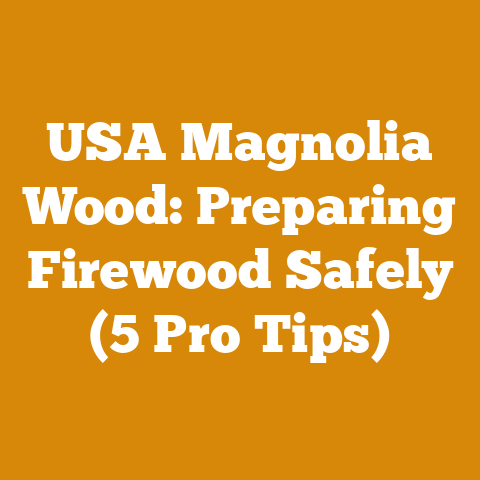Federal Airtight Wood Burning Stove (5 Pro Tips for Safe Use)
It provides efficient, reliable heat, and with proper use, it can be a safe and economical way to keep your family warm throughout the colder months. But like any powerful tool, a wood-burning stove demands respect and a clear understanding of its operation.
In my years of experience felling trees, processing timber, and helping folks optimize their wood-burning systems, I’ve seen firsthand what works and what doesn’t. I’ve seen the joy of a crackling fire on a snowy evening, and I’ve also witnessed the costly – and sometimes dangerous – consequences of neglecting safety protocols. That’s why I’m sharing these five pro tips to help you get the most out of your Federal Airtight Wood Burning Stove while keeping your home and family safe.
Federal Airtight Wood Burning Stove: 5 Pro Tips for Safe Use
Let’s dive into the heart of the matter. We’ll explore everything from choosing the right wood to maintaining your stove to ensure years of efficient, safe heating.
1. Wood Selection: The Foundation of Efficient and Safe Burning
“Garbage in, garbage out” – that old saying applies perfectly to wood-burning stoves. The type of wood you burn dramatically impacts the stove’s efficiency, the amount of creosote buildup, and the overall safety of your heating system.
Seasoned vs. Green Wood: A World of Difference
- Seasoned Wood: This is wood that has been allowed to dry for at least six months, ideally a year or more. The moisture content should be below 20%. Seasoned wood burns hotter, cleaner, and produces significantly less smoke and creosote. Think of it like this: you’re burning the wood, not boiling the water within it.
- Green Wood: Freshly cut wood contains a high moisture content (often 50% or more). Burning green wood is inefficient because a large portion of the fire’s energy is used to evaporate the water, resulting in a cooler fire, more smoke, and accelerated creosote buildup.
I once made the mistake of trying to burn some freshly felled oak in my own stove. The results were dismal. The fire sputtered and smoked, barely producing any heat, and the chimney became coated with creosote in a matter of days. It was a costly lesson in the importance of proper seasoning.
Understanding Wood Species: BTU Content and Burning Characteristics
Different wood species contain different amounts of energy per unit volume, measured in British Thermal Units (BTUs). Hardwoods generally have higher BTU content than softwoods, meaning they produce more heat per cord.
Here’s a quick rundown of common wood species and their burning characteristics:
| Wood Species | BTU Content (Approximate) | Burning Characteristics | Creosote Production |
|---|---|---|---|
| Oak | High | Burns slowly and steadily, producing long-lasting heat. Creates excellent coals. | Moderate |
| Maple | High | Similar to oak, burns well with good heat output. Splits easily. | Moderate |
| Ash | High | Burns readily, even when slightly green. Produces good heat and coals. | Low |
| Birch | Medium | Burns quickly with a bright flame. Good for starting fires but doesn’t last as long as oak or maple. | Moderate |
| Beech | High | Excellent firewood with high heat output and long-lasting coals. | Low |
| Pine | Low | Burns quickly and produces a lot of smoke and creosote. Best used for kindling or short-duration fires. Softwoods like pine contain more resins and sap, which contribute to creosote buildup. I generally avoid burning pine in my airtight stove unless absolutely necessary, and even then, I only use it in small quantities and make sure the stove is burning hot enough to minimize creosote formation. | High |
| Fir | Medium | Similar to pine, burns quickly and produces more creosote than hardwoods. | High |
| Poplar/Aspen | Low | Burns very quickly and produces little heat. Not a good choice for sustained heating. | Low |
| Cherry | Medium | Burns well with a pleasant aroma. Good heat output and easy to split. | Moderate |
| Black Locust | Very High | One of the highest BTU hardwoods. Burns extremely hot and long. Can be difficult to split. | Low |
| Osage Orange | Very High | Another top-tier firewood option. Similar to black locust in heat output and burning duration. Extremely dense and difficult to split. | Low |
Data Point: A study by the US Department of Energy found that burning seasoned hardwood can increase heating efficiency by as much as 30% compared to burning green softwood.
Tips for Proper Wood Storage and Seasoning
- Stack it right: Stack your wood in a single row, off the ground (using pallets or scrap wood), and allow for good air circulation. This promotes even drying.
- Cover the top: Cover the top of the woodpile with a tarp or shed roof to protect it from rain and snow, but leave the sides open for airflow.
- Location, location, location: Choose a sunny, windy location for your woodpile. This will speed up the drying process.
- The “clink” test: When you bang two pieces of seasoned wood together, they should make a clear, resonant “clink” sound. Green wood will sound dull and thuddy.
- Moisture meter: Invest in a wood moisture meter to accurately measure the moisture content of your firewood. Aim for a reading below 20%.
2. Stove Maintenance: A Clean Stove is a Safe Stove
Regular maintenance is crucial for the safe and efficient operation of your Federal Airtight Wood Burning Stove. Neglecting maintenance can lead to reduced efficiency, increased creosote buildup, and even dangerous chimney fires.
Chimney Sweeping: The Creosote Conundrum
Creosote is a highly flammable byproduct of incomplete combustion that accumulates in your chimney. It’s formed when smoke cools and condenses, depositing a tar-like substance on the chimney walls. Regular chimney sweeping is essential to remove creosote and prevent chimney fires.
- Frequency: The National Fire Protection Association (NFPA) recommends that chimneys be inspected at least once a year and cleaned as necessary. If you burn wood frequently, you may need to have your chimney cleaned more often.
- DIY vs. Professional: You can clean your chimney yourself using a chimney sweep kit, but it’s important to do it correctly. If you’re not comfortable with the process, hire a qualified chimney sweep.
- Signs of Creosote Buildup: Watch for these signs that your chimney needs cleaning:
- Thick, black smoke coming from the chimney.
- A strong, pungent odor when the stove is burning.
- Reduced draft.
- A “clicking” or “popping” sound coming from the chimney.
- Visible creosote buildup inside the chimney.
I had a close call one winter when I neglected to clean my chimney for too long. I started hearing a strange crackling sound coming from the chimney, and when I went outside to investigate, I saw flames shooting out of the top. Luckily, I was able to extinguish the fire before it spread to the house, but it was a terrifying experience. I learned my lesson: regular chimney sweeping is not optional; it’s a necessity.
Data Point: According to the Chimney Safety Institute of America (CSIA), chimney fires are a leading cause of residential fires in the United States.
Stove Pipe Inspection and Cleaning
The stove pipe connecting your stove to the chimney also needs regular inspection and cleaning. Check for signs of corrosion, leaks, or creosote buildup. Disconnect the stove pipe annually to clean it thoroughly.
Baffle Inspection and Cleaning
Many Federal Airtight Wood Burning Stoves have a baffle system that helps to improve combustion efficiency. The baffle is a plate or series of plates inside the firebox that directs the flow of smoke and gases, allowing for more complete burning. Inspect the baffle regularly for damage or creosote buildup. Clean it as needed to maintain optimal performance.
Door Gasket Maintenance
The door gasket seals the firebox door, preventing air leaks and ensuring proper combustion. A worn or damaged door gasket can reduce the stove’s efficiency and increase creosote buildup. Inspect the door gasket regularly and replace it if it’s cracked, brittle, or no longer sealing properly.
Ash Removal: A Necessary Chore
Remove ashes from the firebox regularly to maintain proper airflow and prevent the grate from overheating. Allow the ashes to cool completely before disposing of them in a metal container with a tight-fitting lid. Never store ashes indoors or near flammable materials.
I once saw a homeowner who had stored ashes in a cardboard box in his garage. The ashes still contained embers, and they eventually ignited the box, causing a serious fire. Always use a metal container for ash disposal.
Air Intake Cleaning
Most airtight stoves have an adjustable air intake that controls the amount of air entering the firebox. This air is essential for proper combustion. Over time, the air intake can become clogged with dust, debris, or ash. Clean the air intake regularly to ensure that it’s functioning properly.
3. Safe Stove Operation: Mastering the Art of Fire
Operating a wood-burning stove safely requires knowledge, attention, and a healthy dose of common sense. Here are some key principles to keep in mind:
Starting a Fire Safely
- Use the right kindling: Use small, dry pieces of wood and paper to start your fire. Avoid using flammable liquids like gasoline or kerosene.
- Top-Down vs. Bottom-Up: Experiment with different fire-starting methods. Some people prefer the traditional bottom-up method, while others find the top-down method (where the kindling is placed on top of the larger logs) to be more efficient and cleaner-burning.
- Establish a Good Draft: Before lighting the fire, make sure the damper is fully open and the air intake is adjusted to allow for good airflow. This will help to establish a strong draft and prevent smoke from entering the room.
I’ve always found that a well-prepared fire lays the foundation for a safe and efficient burn. I like to use a combination of small kindling, slightly larger sticks, and then gradually introduce the larger logs. Patience is key; don’t rush the process.
Maintaining a Safe Fire
- Don’t Overload the Stove: Overfilling the firebox can restrict airflow and lead to incomplete combustion, resulting in more smoke and creosote. Follow the manufacturer’s recommendations for the maximum amount of wood to load into the stove.
- Air Control is Key: Adjust the air intake to control the burn rate and heat output. A slow, smoldering fire produces more smoke and creosote than a hot, active fire.
- Monitor the Stove Temperature: Use a stove thermometer to monitor the temperature of the stove. Operating the stove within the recommended temperature range will help to ensure efficient combustion and prevent overheating.
Data Point: A study by the Environmental Protection Agency (EPA) found that operating a wood-burning stove at the correct temperature can reduce emissions by up to 50%.
Safe Refueling Practices
- Open the Damper Slowly: Before opening the firebox door to refuel, open the damper slowly to allow the pressure to equalize. This will prevent smoke from puffing out into the room.
- Use a Poker or Tongs: Use a poker or tongs to rearrange the coals and logs before adding more wood. This will help to ensure that the new wood catches fire quickly and burns efficiently.
- Never Leave the Stove Unattended: Never leave a burning stove unattended, especially when refueling.
I remember one time when I was refueling my stove and I didn’t open the damper slowly enough. A cloud of smoke billowed out into the room, setting off the smoke alarm. It was a reminder that even small mistakes can have serious consequences.
Overnight Burning: Proceed with Caution
Burning a stove overnight requires careful attention to safety.
- Use Hardwoods: Burn hardwoods like oak or maple, which burn longer and produce more consistent heat.
- Reduce Airflow: Reduce the air intake to slow down the burn rate.
- Check the Stove Before Bed: Before going to bed, make sure the stove is burning safely and the chimney is drafting properly.
- Install a Carbon Monoxide Detector: Install a carbon monoxide detector in the room with the stove to alert you to the presence of this deadly gas.
I personally prefer not to burn my stove overnight unless absolutely necessary. The risk of carbon monoxide poisoning or a chimney fire is simply too great.
4. Essential Safety Equipment: Protecting Your Home and Family
Investing in essential safety equipment is a non-negotiable aspect of owning a wood-burning stove. These tools and devices can help to prevent accidents and protect your home and family from fire and carbon monoxide poisoning.
Smoke Detectors: Your First Line of Defense
Install smoke detectors on every level of your home, especially near sleeping areas. Test the smoke detectors monthly and replace the batteries at least once a year.
Carbon Monoxide Detectors: The Silent Killer
Carbon monoxide (CO) is a colorless, odorless gas that can be deadly. Install a carbon monoxide detector in the room with the wood-burning stove and in other areas of your home. Test the CO detector monthly and replace the batteries at least once a year.
Data Point: The Centers for Disease Control and Prevention (CDC) estimates that carbon monoxide poisoning causes hundreds of deaths and thousands of hospitalizations each year in the United States.
Fire Extinguisher: Ready for Action
Keep a fire extinguisher readily accessible near the wood-burning stove. Make sure the fire extinguisher is rated for Class A fires (ordinary combustibles like wood and paper). Learn how to use the fire extinguisher properly.
Fireplace Tools: Essential for Safe Fire Management
Invest in a set of fireplace tools, including a poker, tongs, shovel, and broom. These tools will help you to safely manage the fire, rearrange the logs, and remove ashes.
Fire-Resistant Gloves: Protection from the Heat
Wear fire-resistant gloves when handling hot logs or ashes. This will protect your hands from burns.
Hearth Pad: Protecting Your Flooring
A hearth pad is a non-combustible surface that protects your flooring from sparks and embers. Make sure your hearth pad is large enough to extend beyond the stove in all directions, as required by local building codes.
Chimney Thermometer: Monitoring Stove Temperature
A chimney thermometer attaches to the stove pipe and measures the flue gas temperature. This helps you to monitor the stove’s performance and prevent overfiring.
5. Understanding Local Regulations and Codes: Staying Compliant
Before installing and operating a wood-burning stove, it’s essential to understand and comply with local regulations and building codes. These regulations are designed to ensure the safe and responsible use of wood-burning appliances.
Building Permits: Getting the Green Light
In many jurisdictions, you’ll need to obtain a building permit before installing a wood-burning stove. The permit process typically involves submitting plans for the installation and having the installation inspected by a building official.
Clearance Requirements: Maintaining Safe Distances
Building codes often specify minimum clearance distances between the wood-burning stove and combustible materials like walls, furniture, and curtains. These clearance requirements are designed to prevent fires.
Chimney Height and Location: Ensuring Proper Draft
Building codes may also regulate the height and location of the chimney. The chimney must be tall enough to provide adequate draft and prevent smoke from entering neighboring properties.
EPA Regulations: Meeting Emissions Standards
The Environmental Protection Agency (EPA) regulates the emissions from wood-burning stoves. Newer stoves must meet stringent emissions standards to reduce air pollution. Make sure your stove is EPA-certified.
Insurance Requirements: Protecting Your Investment
Check with your homeowner’s insurance company to make sure your wood-burning stove is covered by your policy. Some insurance companies may require you to have your chimney inspected and cleaned annually.
I once helped a friend install a wood-burning stove in his cabin, and he neglected to obtain a building permit. The local building inspector discovered the unpermitted installation and ordered him to remove the stove. It was a costly mistake that could have been avoided by simply following the local regulations.
Data Point: According to the EPA, certified wood stoves release up to 70% less particulate matter pollution than older, non-certified stoves.
Community Considerations: Being a Good Neighbor
Beyond legal requirements, it’s important to be a good neighbor when operating a wood-burning stove. Avoid burning during air quality alerts, and be mindful of the smoke that your stove produces. If your stove is producing excessive smoke, it may be a sign that it’s not operating properly or that you’re burning the wrong type of wood.
By following these five pro tips, you can enjoy the warmth and comfort of your Federal Airtight Wood Burning Stove while keeping your home and family safe. Remember, wood-burning is a responsibility, but with the right knowledge and precautions, it can be a rewarding and economical way to heat your home.
Burning wood is more than just a way to heat your home; it’s a connection to the past, a celebration of self-sufficiency, and a commitment to responsible resource management. By embracing these principles, we can all enjoy the benefits of wood-burning for generations to come.






